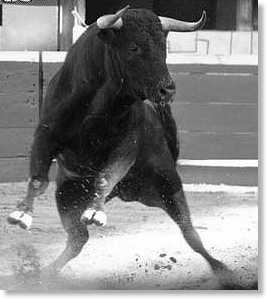

This project explores one of the most colorful, yet controversial, aspects of Hispanic culture: the Spanish bullfight or corrida de toros. Students will practice the four basic language skills of listening, speaking, reading, and writing as they strive to attain the following objectives:
- Understand the early history and background of Mediterranean bull worship.
- Comprehend the events which led to the popularity of the bullfight in Spain.
- Become familiar with some of Spain's famous toreros.
- Be conversant with the modern bullfight and the significance of each part.
- Argue for or against the prohibition of bullfighting.
Evaluation of this project will be based on the following:
- An oral presentation to the class related in some way either to bullfighting or the figure of the bull in Mediterranean culture, art, society, etc.
- An essay that argues for or against the prohibition of bullfighting.
- Active participation in a class tertulia (discussion/debate).
- An article published on the Web as part of a class revista.
- A final examination.
Possible topics for the oral presentation/article include:
- Orígenes de la corrida.
- Descripción y explicación del primer tercio (suerte de varas).
- Descripción y explicación del segundo tercio (suerte de banderillas).
- Descripción y explicación del último tercio (suerte de la muerte).
- El vestimento taurino y las armas.
- Toreros famosos.
- La matadora Cristina Sánchez.
- Pamplona y la Fiesta de San Fermín.
- La campaña antitaurina.
- El toro de lidia.
- Los caballos y el arte del rejoneo.
- La tauromaquia del pintor Francisco Goya.
- Descripción y comentario del cuadro Toreador alucinagénico de Salvador Dalí.
- La figura del toro en la obra de Picasso.
- Descripción y comentario del cuadro Guernica de Picasso.
- Hemingway y los toros.
- Comentario del poema LLanto por Ignacio Mejías de Federico García Lorca (una de las cuatro partes).
- El mito de Teseo y el Minotauro.
- Otras fiestas españolas que se celebran con bovinos.
Students can find much of the information they will need at these websites:
MUNDO TAURINO (información general, enlaces a otros sitios taurinos en el Internet)
DEL ARTE DEL TOREO (buena descripción de las partes de la corrida y de los toros de lidia)
LA CORRIDA DE TOROS (origen histórico y descripción de la corrida)
LA FORMACION TAURINA (síntesis de una corrida, suertes, características del toro, diccionario taurino)
GUIA SAN FERMIN (información sobre Pamplona, sus fiestas, y el encierro)
WEB ANTITAURINA (presenta la posición de los antitoristas y los argumentos a favor de la prohibición de la corrida)
Another good source of information is the companion script and student guide to the video we will see in class: EL ARTE DE LA TAUROMAQUIA. Students can prepare for the final exam by reviewing the TAUROMAQUIA STUDY QUESTIONS.
Additional sources include:
Hemingway, Ernest. The Sun Also Rises (1925); Death in the Afternoon (1933).
Mitchell, Timothy J. Blood Sport: A Social History of Spanish Bullfighting (1991).